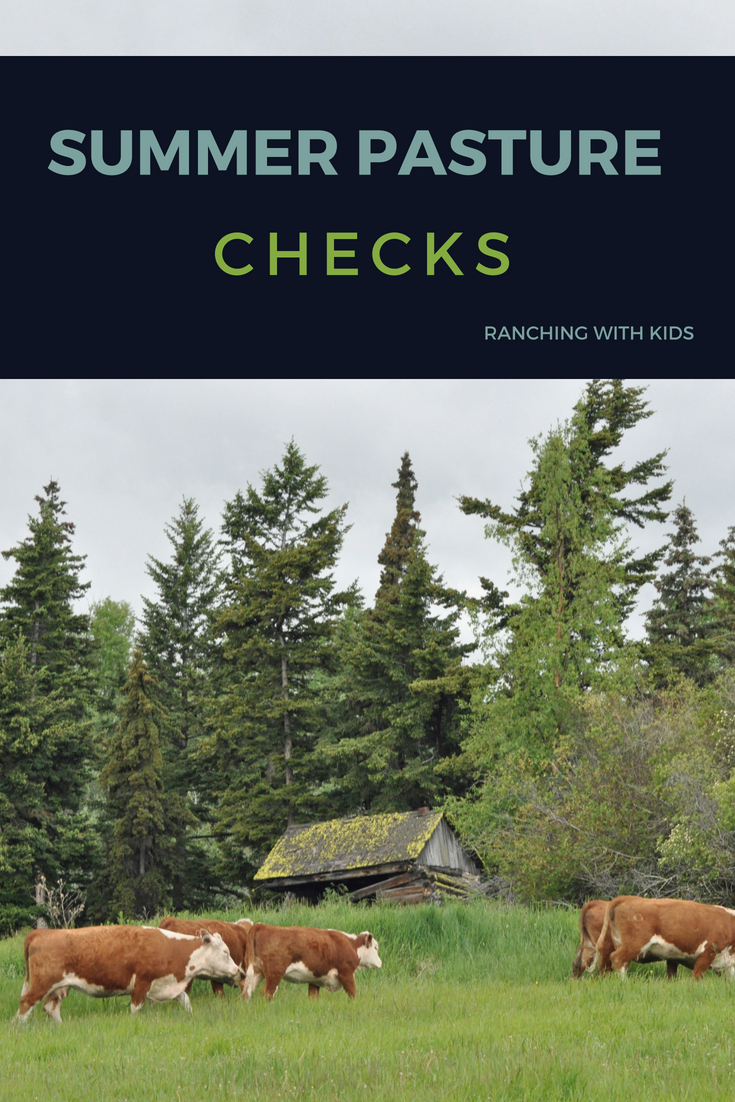We take great care of our animals and our land while raising beef from pasture to plate for our customers. During the summer months, summer pasture checks are a necessary and fun task that we do a regular basis. It is also one of my favourite jobs to do with my boys. Since we homeschool, it is a wonderful way to get outside and study nature. Some days we will even pack a lunch or snack and have a picnic with the cows.

It is extremely important to check pastures on a regular basis to ensure that the animals are healthy and have adequate water and salt. It is also necessary to check the condition of the pasture to help us determine when the cattle need to be moved to maintain and/or improve the land.
Healthy Animals are a Priority
First, we are checking to make sure that the cows, calves and bulls are all healthy. We can easily do this by walking through them quietly. Our cows are quiet enough that they will usually not be disturbed when we walk through them.

We watch to see if the bull is interested in any cows, also known as cycling. If a cow is cycling, we then watch to see if the bull is breeding her. As the summer proceeds, we want to ensure that we are seeing less, or preferably no, cows that are cycling.

Ranch Documentation During Summer Pasture Checks
While I am walking through the herd, I always use this opportunity to take photos of the pasture and the cattle. Photographs are an amazing method to document pasture conditions and cattle genetics. We strive to ensure that our cattle are utilizing the pastures in a way to maintain a healthy grassland ecosystem for many generations to come.

Clean, Fresh Water is a Necessity
We check all the water sources on the pasture to ensure that they are clean, fresh and have an adequate supply. This is extremely important, as water sources can dry up very quickly in the summer. On many summer pastures, we have off-stream watering systems to avoid disturbance to the water source.

Supply of Salt
Cattle must have access to adequate salt and we provide this to our herd in the form of salt blocks on each summer pasture. We must check their salt supply each time and replace with new salt blocks when required. Salt can also be used to encourage cattle to graze different areas of a pasture. By moving the salt blocks to a different location, we can lower the grazing impact in one area while increasing the grazing in another.
Tasks to be Done at Home
When I get home, I upload any photos of individual animals and pasture photos into our herd management program. This helps to assist in documenting our pasture conditions and our cattle genetics. We can look past photos to see how the ecosystem has improved based on our grazing system and it in turn helps us to make grazing management decisions. By inputting photos of individual animals, it helps to us to recognize animals when analysing cattle records.

Striving for Grazing Excellence
Cattle are excellent converters of grass into protein. On our ranch, we strive to ensure that our animals have an abundance of grass while taking care of the grassland ecosystems that we graze. We are continuingly learning about modern technologies and grazing systems to help advance our operation while always considering the environment.


Pin Me


